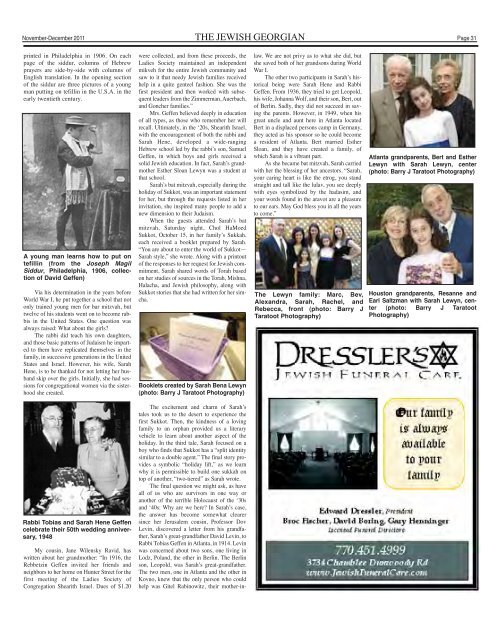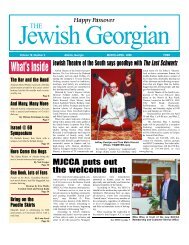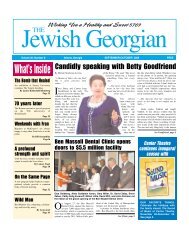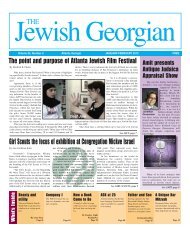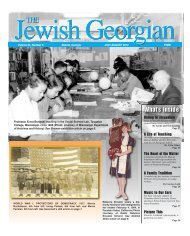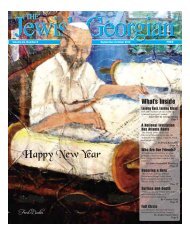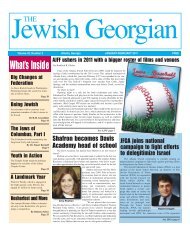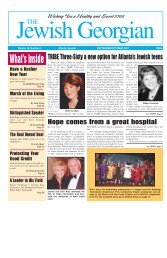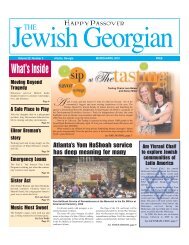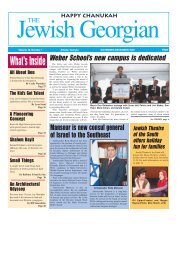Happy Chanukah - The Jewish Georgian
Happy Chanukah - The Jewish Georgian
Happy Chanukah - The Jewish Georgian
You also want an ePaper? Increase the reach of your titles
YUMPU automatically turns print PDFs into web optimized ePapers that Google loves.
November-December 2011 THE JEWISH GEORGIAN Page 31<br />
printed in Philadelphia in 1906. On each<br />
page of the siddur, columns of Hebrew<br />
prayers are side-by-side with columns of<br />
English translation. In the opening section<br />
of the siddur are three pictures of a young<br />
man putting on tefillin in the U.S.A. in the<br />
early twentieth century.<br />
A young man learns how to put on<br />
tefillin (from the Joseph Magil<br />
Siddur, Philadelphia, 1906, collection<br />
of David Geffen)<br />
Via his determination in the years before<br />
World War I, he put together a school that not<br />
only trained young men for bar mitzvah, but<br />
twelve of his students went on to become rabbis<br />
in the United States. One question was<br />
always raised: What about the girls?<br />
<strong>The</strong> rabbi did teach his own daughters,<br />
and those basic patterns of Judaism he imparted<br />
to them have replicated themselves in the<br />
family, in successive generations in the United<br />
States and Israel. However, his wife, Sarah<br />
Hene, is to be thanked for not letting her husband<br />
skip over the girls. Initially, she had sessions<br />
for congregational women via the sisterhood<br />
she created.<br />
Rabbi Tobias and Sarah Hene Geffen<br />
celebrate their 50th wedding anniversary,<br />
1948<br />
My cousin, Jane Wilensky Ravid, has<br />
written about her grandmother: “In 1916, the<br />
Rebbetzin Geffen invited her friends and<br />
neighbors to her home on Hunter Street for the<br />
first meeting of the Ladies Society of<br />
Congregation Shearith Israel. Dues of $1.20<br />
were collected, and from these proceeds, the<br />
Ladies Society maintained an independent<br />
mikveh for the entire <strong>Jewish</strong> community and<br />
saw to it that needy <strong>Jewish</strong> families received<br />
help in a quite genteel fashion. She was the<br />
first president and then worked with subsequent<br />
leaders from the Zimmerman, Auerbach,<br />
and Goncher families.”<br />
Mrs. Geffen believed deeply in education<br />
of all types, as those who remember her will<br />
recall. Ultimately, in the ‘20s, Shearith Israel,<br />
with the encouragement of both the rabbi and<br />
Sarah Hene, developed a wide-ranging<br />
Hebrew school led by the rabbi’s son, Samuel<br />
Geffen, in which boys and girls received a<br />
solid <strong>Jewish</strong> education. In fact, Sarah’s grandmother<br />
Esther Sloan Lewyn was a student at<br />
that school.<br />
Sarah’s bat mitzvah, especially during the<br />
holiday of Sukkot, was an important statement<br />
for her, but through the requests listed in her<br />
invitation, she inspired many people to add a<br />
new dimension to their Judaism.<br />
When the guests attended Sarah’s bat<br />
mitzvah, Saturday night, Chol HaMoed<br />
Sukkot, October 15, in her family’s Sukkah,<br />
each received a booklet prepared by Sarah.<br />
“You are about to enter the world of Sukkot—<br />
Sarah style,” she wrote. Along with a printout<br />
of the responses to her request for <strong>Jewish</strong> commitment,<br />
Sarah shared words of Torah based<br />
on her studies of sources in the Torah, Mishna,<br />
Halacha, and <strong>Jewish</strong> philosophy, along with<br />
Sukkot stories that she had written for her simcha.<br />
Booklets created by Sarah Bena Lewyn<br />
(photo: Barry J Taratoot Photography)<br />
<strong>The</strong> excitement and charm of Sarah’s<br />
tales took us to the desert to experience the<br />
first Sukkot. <strong>The</strong>n, the kindness of a loving<br />
family to an orphan provided us a literary<br />
vehicle to learn about another aspect of the<br />
holiday. In the third tale, Sarah focused on a<br />
boy who finds that Sukkot has a “split identity<br />
similar to a double agent.” <strong>The</strong> final story provides<br />
a symbolic “holiday lift,” as we learn<br />
why it is permissible to build one sukkah on<br />
top of another, “two-tiered” as Sarah wrote.<br />
<strong>The</strong> final question we might ask, as have<br />
all of us who are survivors in one way or<br />
another of the terrible Holocaust of the ‘30s<br />
and ‘40s: Why are we here? In Sarah’s case,<br />
the answer has become somewhat clearer<br />
since her Jerusalem cousin, Professor Dov<br />
Levin, discovered a letter from his grandfather,<br />
Sarah’s great-grandfather David Levin, to<br />
Rabbi Tobias Geffen in Atlanta, in 1914. Levin<br />
was concerned about two sons, one living in<br />
Lodz, Poland, the other in Berlin. <strong>The</strong> Berlin<br />
son, Leopold, was Sarah’s great-grandfather.<br />
<strong>The</strong> two men, one in Atlanta and the other in<br />
Kovno, knew that the only person who could<br />
help was Gitel Rabinowitz, their mother-in-<br />
law. We are not privy as to what she did, but<br />
she saved both of her grandsons during World<br />
War I.<br />
<strong>The</strong> other two participants in Sarah’s historical<br />
being were Sarah Hene and Rabbi<br />
Geffen. From 1936, they tried to get Leopold,<br />
his wife, Johanna Wolf, and their son, Bert, out<br />
of Berlin. Sadly, they did not succeed in saving<br />
the parents. However, in 1949, when his<br />
great uncle and aunt here in Atlanta located<br />
Bert in a displaced persons camp in Germany,<br />
they acted as his sponsor so he could become<br />
a resident of Atlanta. Bert married Esther<br />
Sloan, and they have created a family, of<br />
which Sarah is a vibrant part.<br />
As she became bat mitzvah, Sarah carried<br />
with her the blessing of her ancestors. “Sarah,<br />
your caring heart is like the etrog, you stand<br />
straight and tall like the lulav, you see deeply<br />
with eyes symbolized by the hadasim, and<br />
your words found in the aravot are a pleasure<br />
to our ears. May God bless you in all the years<br />
to come.”<br />
<strong>The</strong> Lewyn family: Marc, Bev,<br />
Alexandra, Sarah, Rachel, and<br />
Rebecca, front (photo: Barry J<br />
Taratoot Photography)<br />
Atlanta grandparents, Bert and Esther<br />
Lewyn with Sarah Lewyn, center<br />
(photo: Barry J Taratoot Photography)<br />
Houston grandparents, Resanne and<br />
Earl Saltzman with Sarah Lewyn, center<br />
(photo: Barry J Taratoot<br />
Photography)


